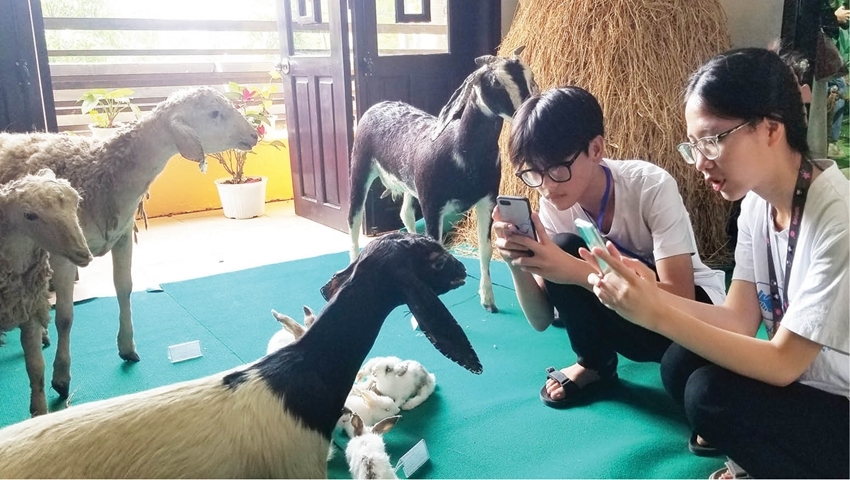 |
| Ms. Le Thi To Nga, Director of the Central Coast Museum of Nature |
In an exchange with Thua Thien Hue Weekly, Ms. Le Thi To Nga, Director of the Central Coast Museum of Nature, reckoned that the Museum had encountered many difficulties and barriers during its operation despite reaping “favorable outcomes”, thereby having been unable to adequately demonstrate biodiversity values through collected specimens.
After nearly 15 years of its “establishment”, what has the Central Coast Museum of Nature achieved?
In 2013, the Provincial People’s Committee issued an approval decision for the detailed construction planning of the Museum in An Tay Ward, Hue City, with an area of 100 hectares. Among which, 70 hectares were reserved for afforestation with a tropical rain forest project, whereas the remaining area was allocated for the construction of the exhibition space, the operational office, and other amenities. To date, there have been more than 40 native tree species being planted and growing green on an area of 67,6 hectares under the tropical rainforest project. As for the Museum’s exhibition center and operational office, they are still temporarily “located” somewhere else.
After a long period of collecting and crafting specimens, the Museum is currently displaying more than 4,500 specimens of 6 main specimen sets such as: geology - minerals, fish, insects, wild animals, forest wood, and bred butterflies. From these specimens, the Museum has exhibited and introduced to people and visitors about biodiversity and its significance, as well as the “mission” of a regional museum of nature.
Considered a miniature natural ecosystem, the Museum is surely attractive to many people, isn’t it?
Despite its limited space, in 2020, the Museum made efforts to re-design and re-arrange the exhibition space in a reasonable and scientific way to welcome visitors. And unexpectedly, since its opening until now, the Museum has attracted many researchers, organizations, projects, pupils, students, etc., to learn, study and support its development.
Not only does it become a place for experiential activities for students and schools, but the Museum also attracts many people from organizations, clubs, projects, etc. These people come to the Museum both to enjoy and to serve as a communication and education bridge to the community about natural resources as well as conservation work.
The Museum also coordinates with universities in the area, such as University of Agriculture and Forestry, University of Sciences, University of Education, Hue University, to sign cooperation agreements, allowing research to be done and students to be taught directly at the Museum with the help of original specimens.
In particular, the Museum has a scientific database of very valuable specimens, helping students to delve deeper into scientific research. Various kinds of centers, including English, painting, and others, also bring students to the Museum to participate in experiential activities. Here, children can learn English through studying specimens, drawing pictures of nature, competing in “Ring the Golden Bell” Contest about biodiversity, practicing crafting specimens, making products through recycled plastic, and learning how to classify waste, etc.
 |
| Students learning and researching specimens at the Museum |
As you mentioned, the operation of the Museum’s exhibition space and operational office is still “temporary” to meet the increasing number of visitors?
It is true that the Museum’s is still temporarily “located”, so the exhibition and storage spaces are still very limited, thereby, being unable to fully express the richness and diversity of specimen sets.
In order to be called a museum of nature, one must combine exhibits and nature with true functional areas. In the planning and development orientation of the Museum, in addition to the tropical rainforest planting area, there will be a space for indoor and outdoor exhibition areas, forming a natural butterfly garden, bird garden, animal garden, etc.
The idea of forming a "beautiful picture" to display all the natural values of the Museum has been around for a long time, but unfortunately, up to now, the desire to have a standard exhibition space still faces many problems.
It is worrying that the without a sufficient exhibition space, the increasing number of collected specimens will go through a cycle of damage and waste when being kept in the storage. So, it is urgent that there is an exhibition space as planned as soon as possible, where the samples can be displayed right after being collected. Only then can the value brought by the specimens be promoted.
The Museum’s specialized activity is to focus on collecting as many specimens and specimen sets as possible. Can you elaborate further on this practice?
The Museum adopts multiple approaches to specimen collection. The first one is performing the functions and tasks of collecting specimens according to a specific plan as well as specimen sets, on the basis of the budget annually allocated by the Department of Science and Technology.
The Museum has also developed a project to collect specimens until 2030, which has been approved by the Provincial People's Committee. The second one is collecting specimens through propaganda and mobilization for people to donate.
In the near future, the Museum will build a support mechanism and coordinate with the Forest Protection Department to propagate and mobilize the collection of specimens from the people, especially the people of the highlands of Nam Dong and A Luoi. The third one is collecting samples through donations from organizations and individuals such as from universities and faculties with many specimen sets stored during the teaching process.
Another approach is through the implementation of scientific and technological projects at the provincial and national levels to collect specimens that are stable, rich and diverse. For example, the Museum is implementing a central-level science and technology project to research and collect bird specimens in the lagoon system of 14 central provinces. The research findings are expected to bring about a huge set of specimens.
In addition, from the artifacts and exhibits obtained from illegally hunting, trading, and transporting wild animals, the Museum also connects, approaches, and coordinates with agencies and functional forces such as security, forest rangers, market managers, etc., inside and outside the province to request collection. At the same time, it also collects from the “consignment” channel to preserve exhibits, following the appropriate procedures, avoiding damage at the Museum after the case is closed.
Crafting the specimens is also an equally important step and technique, right ma'am?
In fact, it is not easy to craft a complete, original specimen that can be preserved for a long time. In fact, this requires a whole process of apprenticeship and thorough vocational training. Each specimen has a different way of being crafted. For example, it is essential that one gain the experience of handling and soaking each kind of coat with different chemicals.
After being collected, the specimens would be brought to Scientific Research Institute of Highland. Here, members of the Museum will be able to learn and practice crafting their own specimens. This is the most effective way to train them via learning and doing, and the Museum usually appoints 2 to 3 members to take part in the training course every year. The Museum highly appreciate the dedication of the Scientific Research Institute of Highland in instructing its members how to craft, helping it to obtain more and more precious and valuable crafted specimens for storage, preservation and media education.
Thank you, ma'am!